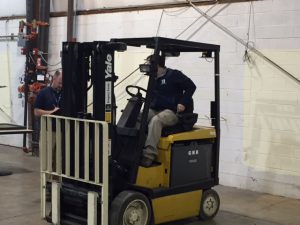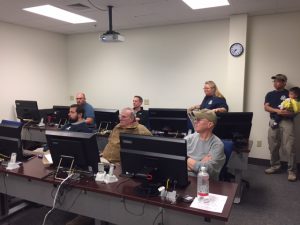Duke Coalition Steering Committee Meets to plan year
Author: nctcadmin
CMS EM Final Rule: organizations required to have two emergency operations plan exercises
CMS EXERCISE UPDATE
The Joint Commission confirmed with the Centers for Medicare and Medicaid Services (CMS) that organizations are required to have two exercises of their emergency operations plan annually (responses to actual disasters can serve in lieu of planned exercises). This is required as part of the standards that became effective on Nov. 15, 2017, in response to CMS’ Emergency Management Final Rule.
Leave this site and read the entire Joint Commission article here.
Hospitals, Others Share Evacuation Lessons from 2017 Hurricanes, Wildfires
Hospitals, Others Share Evacuation Lessons
The latest newsletter from the Department of Health and Human Services’ Office of the Assistant Secretary for Preparedness and Response highlights evacuation stories from last year’s hurricanes and wildfires. Among other stories, Kaiser Permanente officials share their personal and professional experiences evacuating a hospital in the midst of the California wildfires, and a Baptist Beaumont (TX) Hospital official shares how staff worked tirelessly to care for patients during Hurricane Harvey.
Leave this site and access the full ASPR TRACIE newsletter
Flu Surge Questions grow
Influenza-like illness (ILI) surge and options for surge management. The program office for the State Hospital Preparedness Program has shared the following regarding influenza-like illness (ILI) surge and options for surge management:
Any requests for approval of bed increase or alternation, temporary facilities including soft structures, or other alterations to operations will need to be routed through the appropriate regulatory section at DHSR. Before we can clear any of these alterations that are utilizing SMRS equipment, the DHSR section will need to have approved. A couple of reminders: per CMS, billing cannot be completed in soft structures and you cannot move patients from a hard to soft structure.
Second, the Acute Care Section shared the regulation on alteration of bed capacity that is listed below for reference.
Finally, 1135 waivers require both the US HHS Secretary to declare a public health emergency and a Presidential declaration under the National Emergencies Act or Stafford Act. More information on current waivers can be found here.
10A NCAC 13B .3111 TEMPORARY CHANGE IN BED CAPACITY
(a) A hospital may temporarily increase its bed capacity by up to 10 percent over its licensed bed capacity, as determined by the administrator, by utilizing observational beds for inpatients for a period of no more than 60 consecutive days following approval by the Division of Health Service Regulation.
(b) To qualify for a temporary change in licensed capacity, the hospital census shall be at least 90 percent of its licensed bed capacity, excluding beds that are under renovation or construction, and the hospital must demonstrate conditions requiring the temporary increase that may include but are not limited to the following:
(1) natural disaster;
(2) catastrophic event; or
(3) disease epidemic.
(c) The Division may approve a temporary increase in licensed beds only if:
(1) It is determined that the request has met the requirements of Paragraphs (a) and (b) of this Rule; and
(2) The hospital administrator certifies that the physical facilities to be used are adequate to safeguard the health and safety of patients. However this approval shall be revoked if the Division determines, as a result of a physical site visit, that these safeguards are not adequate to safeguard the health and safety of patients.
History Note: Authority G.S. 131E-79;
Eff. April 1, 2003;
Pursuant to G.S. 150B-21.3A, rule is necessary without substantive public interest Eff. July 22, 2017.
NC Triangle Coalition Announces Website New Look
New look for NCTC Website. We are pleased to announce the launch of our updated website! After months of hard work and dedication, we are delighted to officially announce updates complete. The website is an effort by the three Coalitions (CapRAC, Duke, and MidCarolina) who form the collaborative NC Triangle Coalition in order to share resources, reduce redundancy, and consolidate preparedness efforts in our regions.
While remaining separate entities, the three Coalitions share this updated site with a goal to provide our visitors an easier way to learn about Coalition services and initiatives in an easier environment than previously established. The new website is interactive and gives better access to Who we are, What we Do, The State Medical Assistance Team, and relevant Disaster Resources.
Current and prospective clients will find useful information about our services on the homepage of our website. There, you may use the interactive features to identify which coalition you belong to simply by clicking on your County. A pop up will appear to allow you to affiliate with that Coalition or affiliate later. Affiliation allows that Coalition to access contact information entered on the screen. The Who we serve feature on the homepage will pull up the key response partners (Emergency Management, EMS, Public Health Agency) for each County.
Also on the Home page are listings for events, articles, and response RSS feeds designed to foster improved communication with stakeholders. We will be constantly updating our content with helpful information, articles, Coalition announcements and stakeholder successes in the News section.
The Resources page holds downloadable information, best practices and guidance from organizations such as CMS, The Joint Commission, ASPR, CDC, FEMA, and many others. Links to these and many other organizations are also included on this page.
The individual Coalition pages will highlight each Coalition’s administrative documents (Bylaws, meeting minutes, etc) as well as highlight projects we have completed and attempt to outline the value created for each stakeholder as a result. We hope you find the new website with a fresh look- easy to access information and we also wish to establish this portal as a source of information for those who visit our site. We graciously request that you consider your own facilities preparedness information and best practices for submission to our site.
We invite you to learn more about the Coalition and to contact us at info@nctriaglecoalition.org any time if we can be of assistance.
Thank You!
CapRAC Long Term Care Preparedness
CapRAC is currently undertaking an evacuation project with long term care and assisted living facilities in the region to assist in their preparedness efforts. Working closely with local emergency management, CapRAC has identified several large facilities in Franklin and Harnett Counties to receive grant-funded evacuation devices and training over the next several weeks. The CapRAC Logistics and Training Specialist, Steve Harrison, will provide device training to facility staff and to local EMS agency personnel. Johnston, Lee and Wake Counties will also receive evacuation devices and training during the current grant year. For more information, please contact Steve Harrison.
CapRAC Strategic Planning Workday
The CapRAC Healthcare Coalition held a Strategic Planning Workday on September 29th. Coalition partners came together to review the ASPR Healthcare Coalition Deliverable Assessment Factors and to determine the priorities for our region for the upcoming 5-year preparedness grant cycle. The group was able to come to a consensus on an overall priority roadmap for the Coalition. The regional staff would like to thank everyone that participated and offered their feedback. Check back for the detailed plan to be posted shortly.
Duke SMAT responds during Hurricane Matthews
The aftermath of Hurricane Matthew was difficult enough for people in the hard-hit Goldsboro area who lost their homes due to flooding, or whose electrical power was disrupted. But for those with chronic medical care needs – people on oxygen, diabetics on insulin, elderly needing home care for feeding or bandage management, and others – the challenge of being displaced from their homes was even greater, and potentially life-threatening………
Duke SMAT 400 Conducts first bi-monthly Training session of the new year
The New Year started off on a very positive note for the Duke State Medical Assistance Team. The first bi monthly Team training of 2017 began with 16 team members in attendance. Our two focal points were building our capability logistically and enhancing our understanding of the differing influences on patient triage. Our team now has a total 9 members that are certified to function in our warehouse as forklift operators. For those of you that know the configuration of our medical supplies, that is a major benefit when managing a deployment of assets. As our logistics staff were learning the safe operation of our equipment, with the assistance of one of our more experienced Registered Nurses, our medical staff learned about our differing missions and how patient triage in a trauma scenario differs from that of a patient being accepted into a State Medical Support Shelter or in the event of an evacuation from a medical facility.
Our next meeting will be conducted on March 16th as part of a full scale exercise to include players from local, State and Federal partners. This exercise will test the ability to manage a large influx of patients during a State and Federal Evacuation in response to a hurricane. Our role will be to assist with patient management at Raleigh Durham Airport for the National Disaster Medical System and will test some of the triage principles that we reviewed this month. Thank you to all of those who attended for making Saturday morning a success.


